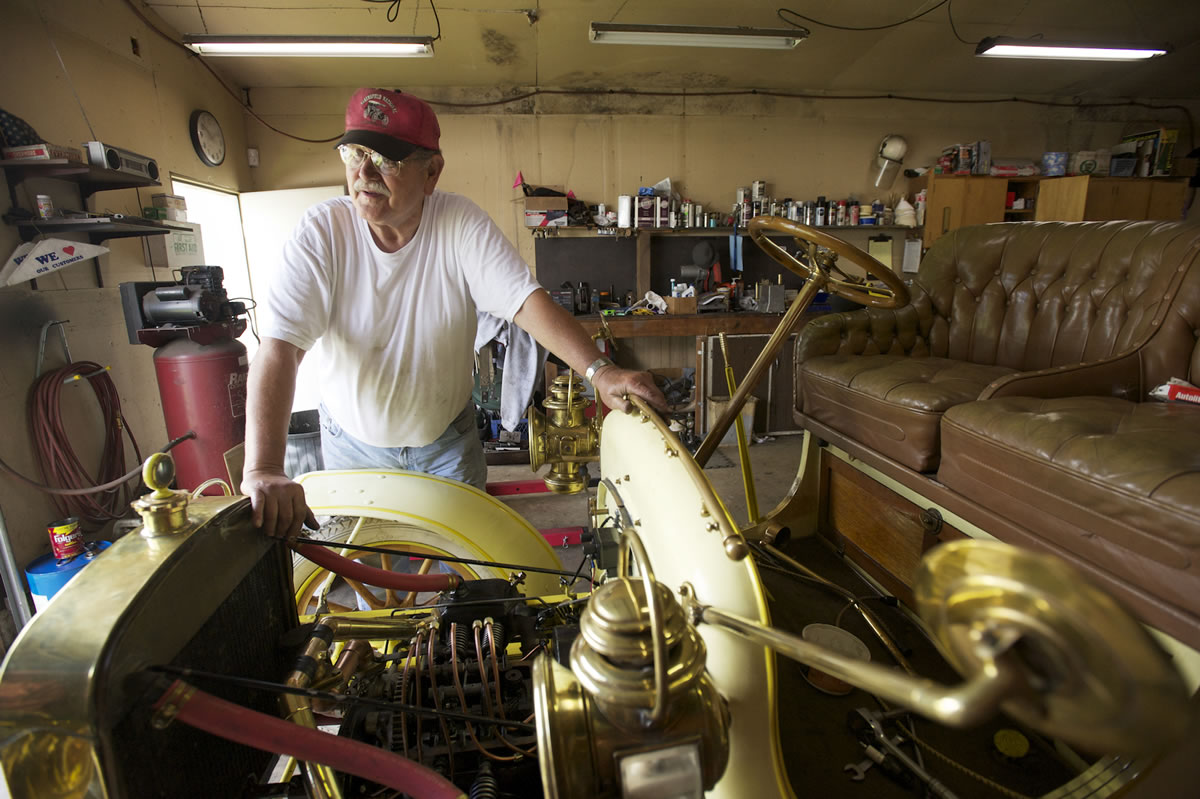Several horseless carriages will be on local roads this week, but people will be able to take a closer look at a couple of stops:
Today, the group will be at the Clark County Historical Museum, 1511 Main St., from about noon to 1 p.m., and then at Beaches Restaurant, 1919 S.E. Columbia River Drive, until about 3 p.m.
On Thursday, people can see the vehicles at the Gateway Inn Express, 13101 N.E. 27th Ave., in Salmon Creek, after about 4 p.m.
A horseless carriage in an east Vancouver shop has chugged its way through a significant portion of American history. It is 105 years old, after all.
Several horseless carriages will be on local roads this week, but people will be able to take a closer look at a couple of stops:
Today, the group will be at the Clark County Historical Museum, 1511 Main St., from about noon to 1 p.m., and then at Beaches Restaurant, 1919 S.E. Columbia River Drive, until about 3 p.m.
On Thursday, people can see the vehicles at the Gateway Inn Express, 13101 N.E. 27th Ave., in Salmon Creek, after about 4 p.m.
Consider whom this 1907 Cartercar might have transported during the past century. A man who was 60 years old in 1907 might have fought in the Civil War.
Back when this vehicle still had its new-horseless-carriage smell, many men in their 60s had voted for Abraham Lincoln in the 1864 presidential election. (Women wouldn’t vote for presidents until 1920).
Now, Frank and Laura Hurley are taking that car out for a spin, and the Vancouver couple will have company. They’ve organized an event for Pacific Northwest enthusiasts that is scheduled to bring half a dozen or so horseless carriages to Vancouver this week.
The assembly, known as a tour, runs through Friday and is centered at the Gateway Inn Express, 13101 N.E. 27th Ave., about a half-mile east of the Interstate 5/I-205 junction.
Frank Hurley, past president of the Horseless Carriage Club of America, said the group defines horseless carriages as motor vehicles built prior to 1916.
This week’s gathering is scheduled to include a 1910 Stanley Steamer, a 1906 Maxwell, a 1908 REO, a 1906 Buick roadster and a 1909 Buick touring car.
They offer some history lessons on how the automobile has transformed America, and how America has transformed the automobile, Laura Hurley said.
Take the wheel
Take the steering wheel, for example: The Cartercar’s driver sits on the right side of the front seat. Roads at the dawn of the 20th century were so bad that, “you had to see where the ditch was,” Frank Hurley said.
Within 10 years, steering wheels on all American-made cars were on the left side, making it easier for a driver to judge the space between his car and vehicles in the oncoming lane.
Horseless carriages also illustrated a shift in production trends.
“In 1907 and 1908, there were more than 1,000 auto manufacturers, including people who built them in blacksmith shops and in barns,” Frank Hurley said.
Most went out of business or were folded into other companies. Buick is the only horseless carriage manufacturer represented at this week’s tour that is still making cars, he noted.
Cartercar was acquired by General Motors, which was interested in the innovative transmission system invented by Byron Carter.
“You might call it the first automatic transmission,” Hurley said. “It’s a friction drive, and you don’t have to shift it.”
The engine spins a disk under the car. Another plate, parallel to the car’s wheels, contacts the first plate at a right angle. As friction makes the second plate rotate, it powers a chain that drives the rear wheels.
Like other horseless carriage operators, Hurley uses a hand crank to start the engine. If you’re not careful, he warned, the crank can kick back and break your arm.
Death drove inventor
That’s where designer Byron Carter became part of another automotive innovation, unfortunately. According to a GM heritage website, Carter died in 1908 after a balky crank kicked back and hit him in the face.
Charles Kettering, cofounder of Dayton Engineering Laboratories Co. (Delco), heard about the tragedy. He invented the first electric car starter, using a small electric motor he’d designed while working at the National Cash Register Co.
(The auto industry and its pioneers obviously created a lot of ripples. Before Kettering retired from GM in 1947, he helped establish the Sloan-Kettering Institute for Cancer Research.)
The 1907 Cartercar is one of 264 that were built. Hurley ballparked its value at about $70,000, although he said he’s turned down six figures for it.
Despite its vintage, the two-cylinder car is no museum piece.
“I’ve owned this for 20 years, and I’ve put 10,000 miles on it,” Frank Hurley said.
The Hurleys do trailer it to different parts of the country, but events such as this week’s gathering include driving tours.
‘We stay on the back roads,” Frank Hurley added.
There is a knack to keeping century-old automobiles in running condition, but it’s becoming a lost art. Hurley said he really appreciates the assistance of Battle Ground resident Bob Kujava, who’s been working on the Cartercar’s distributor.
“This stuff is fun,” Kujava said.
When he opened a service station in 1957, Kujava said, “I could rebuild a starter or generator or distributor for any car on the road.”
The 1907 Cartercar requires old-school gasoline, Frank said; ethanol damages engine parts.
Keeping a horseless carriage in good working order is important, Frank said, because these vehicles will eventually move along to new generations of owners.




